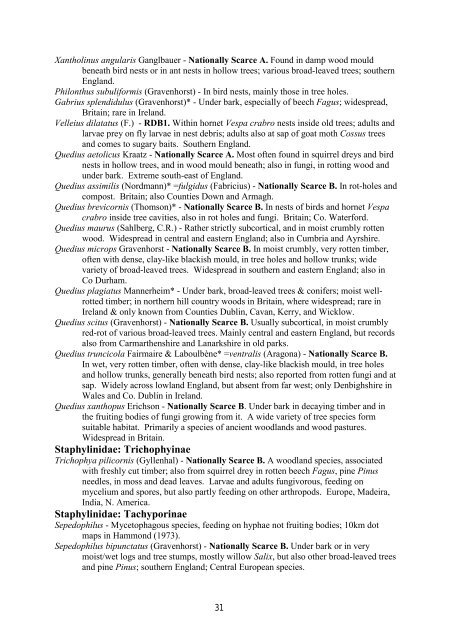Crustacea: Copepoda - Cerambycoidea.com
Crustacea: Copepoda - Cerambycoidea.com
Crustacea: Copepoda - Cerambycoidea.com
You also want an ePaper? Increase the reach of your titles
YUMPU automatically turns print PDFs into web optimized ePapers that Google loves.
Xantholinus angularis Ganglbauer - Nationally Scarce A. Found in damp wood mould<br />
beneath bird nests or in ant nests in hollow trees; various broad-leaved trees; southern<br />
England.<br />
Philonthus subuliformis (Gravenhorst) - In bird nests, mainly those in tree holes.<br />
Gabrius splendidulus (Gravenhorst)* - Under bark, especially of beech Fagus; widespread,<br />
Britain; rare in Ireland.<br />
Velleius dilatatus (F.) - RDB1. Within hornet Vespa crabro nests inside old trees; adults and<br />
larvae prey on fly larvae in nest debris; adults also at sap of goat moth Cossus trees<br />
and <strong>com</strong>es to sugary baits. Southern England.<br />
Quedius aetolicus Kraatz - Nationally Scarce A. Most often found in squirrel dreys and bird<br />
nests in hollow trees, and in wood mould beneath; also in fungi, in rotting wood and<br />
under bark. Extreme south-east of England.<br />
Quedius assimilis (Nordmann)* =fulgidus (Fabricius) - Nationally Scarce B. In rot-holes and<br />
<strong>com</strong>post. Britain; also Counties Down and Armagh.<br />
Quedius brevicornis (Thomson)* - Nationally Scarce B. In nests of birds and hornet Vespa<br />
crabro inside tree cavities, also in rot holes and fungi. Britain; Co. Waterford.<br />
Quedius maurus (Sahlberg, C.R.) - Rather strictly subcortical, and in moist crumbly rotten<br />
wood. Widespread in central and eastern England; also in Cumbria and Ayrshire.<br />
Quedius microps Gravenhorst - Nationally Scarce B. In moist crumbly, very rotten timber,<br />
often with dense, clay-like blackish mould, in tree holes and hollow trunks; wide<br />
variety of broad-leaved trees. Widespread in southern and eastern England; also in<br />
Co Durham.<br />
Quedius plagiatus Mannerheim* - Under bark, broad-leaved trees & conifers; moist wellrotted<br />
timber; in northern hill country woods in Britain, where widespread; rare in<br />
Ireland & only known from Counties Dublin, Cavan, Kerry, and Wicklow.<br />
Quedius scitus (Gravenhorst) - Nationally Scarce B. Usually subcortical, in moist crumbly<br />
red-rot of various broad-leaved trees. Mainly central and eastern England, but records<br />
also from Carmarthenshire and Lanarkshire in old parks.<br />
Quedius truncicola Fairmaire & Laboulbène* =ventralis (Aragona) - Nationally Scarce B.<br />
In wet, very rotten timber, often with dense, clay-like blackish mould, in tree holes<br />
and hollow trunks, generally beneath bird nests; also reported from rotten fungi and at<br />
sap. Widely across lowland England, but absent from far west; only Denbighshire in<br />
Wales and Co. Dublin in Ireland.<br />
Quedius xanthopus Erichson - Nationally Scarce B. Under bark in decaying timber and in<br />
the fruiting bodies of fungi growing from it. A wide variety of tree species form<br />
suitable habitat. Primarily a species of ancient woodlands and wood pastures.<br />
Widespread in Britain.<br />
Staphylinidae: Trichophyinae<br />
Trichophya pilicornis (Gyllenhal) - Nationally Scarce B. A woodland species, associated<br />
with freshly cut timber; also from squirrel drey in rotten beech Fagus, pine Pinus<br />
needles, in moss and dead leaves. Larvae and adults fungivorous, feeding on<br />
mycelium and spores, but also partly feeding on other arthropods. Europe, Madeira,<br />
India, N. America.<br />
Staphylinidae: Tachyporinae<br />
Sepedophilus - Mycetophagous species, feeding on hyphae not fruiting bodies; 10km dot<br />
maps in Hammond (1973).<br />
Sepedophilus bipunctatus (Gravenhorst) - Nationally Scarce B. Under bark or in very<br />
moist/wet logs and tree stumps, mostly willow Salix, but also other broad-leaved trees<br />
and pine Pinus; southern England; Central European species.<br />
31

















